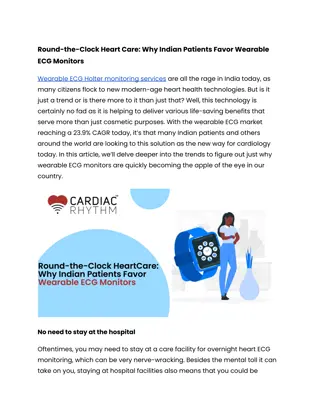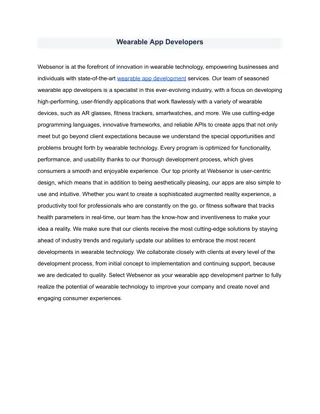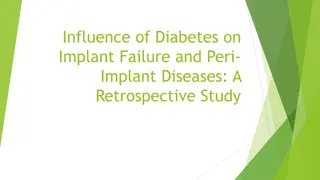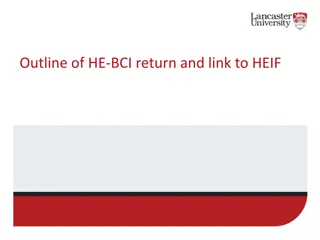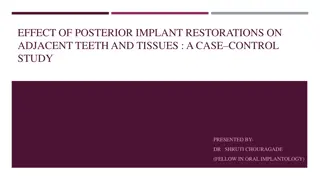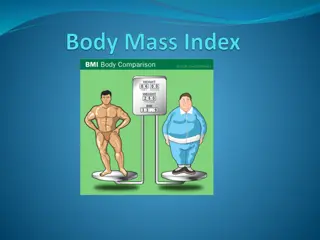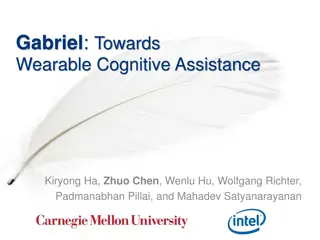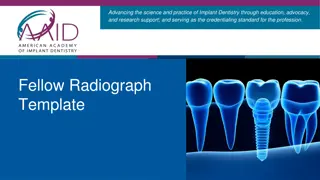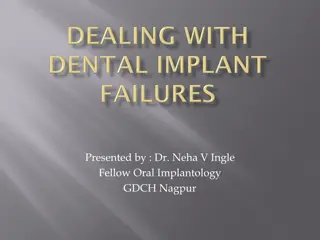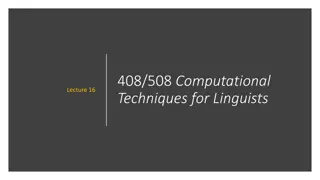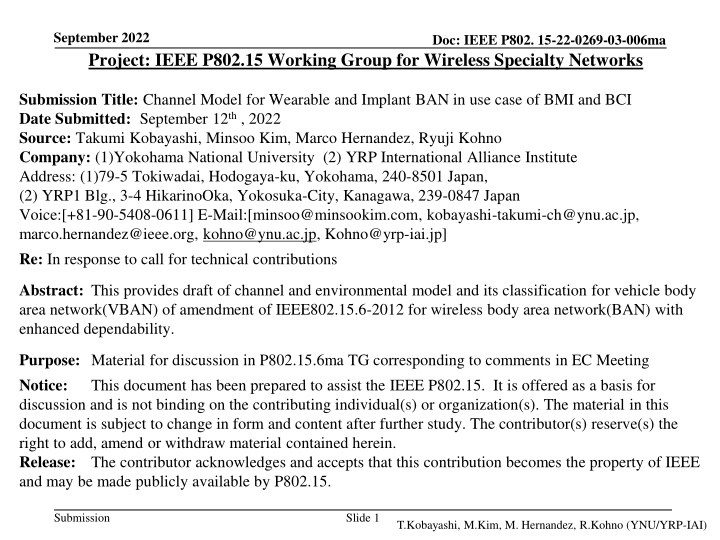
Channel Model for Wearable and Implant BAN in Use Case of BMI and BCI
Explore the channel model for the vehicle body area network (VBAN) in the context of IEEE 802.15.6-2012. This submission presents a draft of the channel and environmental model for wireless body area networks (BAN) to enhance dependability. It covers classifications for human and vehicle body area networks, including HBAN and VBAN models. The document addresses various scenarios and models, such as on-body, in-body (implant), and BCI models, emphasizing the importance of defining the most dominant model.
Download Presentation

Please find below an Image/Link to download the presentation.
The content on the website is provided AS IS for your information and personal use only. It may not be sold, licensed, or shared on other websites without obtaining consent from the author. If you encounter any issues during the download, it is possible that the publisher has removed the file from their server.
You are allowed to download the files provided on this website for personal or commercial use, subject to the condition that they are used lawfully. All files are the property of their respective owners.
The content on the website is provided AS IS for your information and personal use only. It may not be sold, licensed, or shared on other websites without obtaining consent from the author.
E N D
Presentation Transcript
September 2022 Doc: IEEE P802. 15-22-0269-03-006ma Project: IEEE P802.15 Working Group for Wireless Specialty Networks Submission Title: Channel Model for Wearable and Implant BAN in use case of BMI and BCI Date Submitted: September 12th, 2022 Source: Takumi Kobayashi, Minsoo Kim, Marco Hernandez, Ryuji Kohno Company: (1)Yokohama National University (2) YRP International Alliance Institute Address: (1)79-5 Tokiwadai, Hodogaya-ku, Yokohama, 240-8501 Japan, (2) YRP1 Blg., 3-4 HikarinoOka, Yokosuka-City, Kanagawa, 239-0847 Japan Voice:[+81-90-5408-0611] E-Mail:[minsoo@minsookim.com, kobayashi-takumi-ch@ynu.ac.jp, marco.hernandez@ieee.org, kohno@ynu.ac.jp, Kohno@yrp-iai.jp] Re: In response to call for technical contributions Abstract: This provides draft of channel and environmental model and its classification for vehicle body area network(VBAN) of amendment of IEEE802.15.6-2012 for wireless body area network(BAN) with enhanced dependability. Purpose: Material for discussion in P802.15.6ma TG corresponding to comments in EC Meeting Notice: This document has been prepared to assist the IEEE P802.15. It is offered as a basis for discussion and is not binding on the contributing individual(s) or organization(s). The material in this document is subject to change in form and content after further study. The contributor(s) reserve(s) the right to add, amend or withdraw material contained herein. Release: The contributor acknowledges and accepts that this contribution becomes the property of IEEE and may be made publicly available by P802.15. Submission Slide 1 T.Kobayashi, M.Kim, M. Hernandez, R.Kohno (YNU/YRP-IAI)
September 2022 Doc: IEEE P802. 15-22-0269-03-006ma Channel Model for Wearable and Implant BAN in use case of BMI and BCI Takumi Kobayashi(1,2), Marco Hernandez(2), Minsoo Kim(2), Ryuji Kohno(1,2) (1)Yokohama National University, (2)YRP-International Ariane Institute Submission Slide 2 T.Kobayashi, M.Kim, M. Hernandez, R.Kohno (YNU/YRP-IAI)
September 2022 Classification of Channel and Environment Models for Human and Vehicle Body Area Networks (HBAN&VBAN) Channel model On-body Around body model With environ ment not covered in 2012 Doc: IEEE P802. 15-22-0269-03-006ma Covered by IEEE 802.15.6-2012 HBAN model In-body (Implant) Channel Around means; Desk, WiFi AP in the room etc. Outdoor Indoor Home Office Medical (e.g. Hospital) Implanted BCI model On skull BCI model capsule endoscopy VBAN model In-vehicle Engine compartment Cabin Through Engine compartment and cabin Roof Side Right/Left/Front/back Bottom Static vehicle Moving vehicle Note: HBAN-model: -Environment with co-existing systems is not considered. On-vehicle Around vehicle VBAN model: Key-less entry system Localization in-body, on-body Most dominant model should be defined and separatory defined as Mandatory and Optional. 3 Submission T.Kobayashi, M.Kim, M. Hernandez, R.Kohno (YNU/YRP-IAI)
September 2022 Channel models and scenarios in IEEE802.15.6-2012 Doc: IEEE P802. 15-22-0269-03-006ma IEEE P802.15-08-0780-12-0006-TG6 IEEE 802.15.6-2012 channel models considered Fading ( Small scale/ large scale) Path loss Shadowing Power delay profile In-body (implant) On-body (body surface) CM1, 2, 3, 4 Scenario 1, to Scenario 7. (S1 S7) Submission Slide 4 T.Kobayashi, M.Kim, M. Hernandez, R.Kohno (YNU/YRP-IAI)
September 2022 Channel models and scenarios in IEEE802.15.6ma Doc: IEEE P802. 15-22-0269-03-006ma Scen ario Channel Model Description Frequency Band S2 Implant to Body Surface 402-405 MHz, CM2 Implant (upper body) to Body Surface 3.1-10.6 GHz UWB CM2.1 S2.1 Implant (head) to Body Surface 3.1-10.6 GHz UWB CM2.2 S2.2 402-405 MHz, 3.1-10.6 GHz UWB S3 Implant to External CM2 Body Surface to Body Surface (LOS) 400, 600, 900 MHz 2.4, 3.1-10.6 GHz S4 CM3 Path loss (Mandatory) Optional; Fading ( Small scale/ large scale) Shadowing Power delay profile Body Surface to Body Surface (LOS) 3.1-10.6 GHz CM4.1 CM4.1 S4.1 Body Surface to Body Surface (NLOS) 400, 600, 900 MHz 2.4, 3.1-10.6 GHz S5 CM3 Specific use cases Body Surface to External (LOS) 900 MHz 2.4, 3.1-10.6 GHz S6 CM4 Implant to Body Surface for BCI Body Surface (head) to External (LOS) Implant to External for BCI 3.1-10.6 GHz CM6.1 S6.1 Body surface to body surface for BCI Body Surface to External (NLOS) 900 MHz 2.4, 3.1-10.6 GHz Body Surface to External for BCI S7 CM4 Implant to body surface for capsule endoscopy Submission Slide 5 T.Kobayashi, M.Kim, M. Hernandez, R.Kohno (YNU/YRP-IAI)
September 2022 Channel models and scenarios in use case of BMI and BCI Doc: IEEE P802. 15-22-0269-03-006ma Specific use cases Implant to Body Surface for BCI Implant to External for BCI We will define what is BCI and BMI. Body surface to body surface for BCI Body Surface to External for BCI Implant to body surface for capsule endoscopy Wired connection Body Surface to Body Surface for BCI Implant to Body Surface for BCI Body Surface to External for BCI Implant to External for BCI Submission Slide 6 T.Kobayashi, M.Kim, M. Hernandez, R.Kohno (YNU/YRP-IAI)
September 2022 Suggestion from Prof. Hirata Implant to implant model for next Gen. Doc: IEEE P802. 15-22-0269-03-006ma Submission Slide 7 T.Kobayashi, M.Kim, M. Hernandez, R.Kohno (YNU/YRP-IAI)
September 2022 BCI implanted device configuration Skin Doc: IEEE P802. 15-22-0269-03-006ma Skull bone <10mm Skin Brain Device electrodes Skull bone Skull bone Brain Skin Device Skin Skull bone Skull bone Device Brain Brain Brain Submission Slide 8 T.Kobayashi, M.Kim, M. Hernandez, R.Kohno (YNU/YRP-IAI)
September 2022 1stgeneration Doc: IEEE P802. 15-22-0269-03-006ma Receiver Device Skin muscle membrane <10mm Transmitter Device Skull bone Skull bone electrodes Wired connection Brain Submission Slide 9 T.Kobayashi, M.Kim, M. Hernandez, R.Kohno (YNU/YRP-IAI)
September 2022 1.5 Gen. Doc: IEEE P802. 15-22-0269-03-006ma Receiver can be placed any where on body like on arm, wrist, neck etc. Receiver Device Transmitter Device Skin <10mm Skull bone Skull bone electrodes Brain Submission Slide 10 T.Kobayashi, M.Kim, M. Hernandez, R.Kohno (YNU/YRP-IAI)
September 2022 1.5 Gen. Doc: IEEE P802. 15-22-0269-03-006ma Receiver can be placed any where on body like on arm, wrist, neck etc. Receiver Device Receiver Device Transmitter Device Skin <10mm Skull bone Skull bone electrodes Brain Submission Slide 11 T.Kobayashi, M.Kim, M. Hernandez, R.Kohno (YNU/YRP-IAI)
September 2022 Channel models for BMI and BCI S2.2 (A) implant(head) to on-body Doc: IEEE P802. 15-22-0269-03-006ma Specific use cases Implant(head) to on-body for BCI Implant to External for BCI Body surface to body surface for BCI Body Surface to External for BCI Implant to body surface for capsule endoscopy Submission Slide 12 T.Kobayashi, M.Kim, M. Hernandez, R.Kohno (YNU/YRP-IAI)
September 2022 Channel models for BMI and BCI S2.2 (B,C) implant(head) to on-body Doc: IEEE P802. 15-22-0269-03-006ma Specific use cases Implant(head) to on-body for BCI Implant to External for BCI Body surface to body surface for BCI Body Surface to External for BCI Implant to body surface for capsule endoscopy Receiver Receiver <10mm Tx antenna Skin tissues <10mm Skin tissues Skull bone Skull bone Skull bone electrodes Tx antenna electrodes transmitter Brain Brain Submission Slide 13 T.Kobayashi, M.Kim, M. Hernandez, R.Kohno (YNU/YRP-IAI)
September 2022 Channel models for BMI and BCI S4.1 on-body(head) to on-body Doc: IEEE P802. 15-22-0269-03-006ma Specific use cases On-body (head) transmitter device Implant(head) to on-body for BCI Implant to External for BCI Body surface to body surface for BCI Body Surface to External for BCI Receiver Device Implant to body surface for capsule endoscopy Submission Slide 14 T.Kobayashi, M.Kim, M. Hernandez, R.Kohno (YNU/YRP-IAI)
September 2022 Channel models for BMI and BCI S6.1 on-body(head) to external Doc: IEEE P802. 15-22-0269-03-006ma Specific use cases On-body (head) transmitter device Implant(head) to on-body for BCI Implant to External for BCI Body surface to body surface for BCI Body Surface to External for BCI Implant to body surface for capsule endoscopy Receiver Device Submission Slide 15 T.Kobayashi, M.Kim, M. Hernandez, R.Kohno (YNU/YRP-IAI)
September 2022 Future generation Doc: IEEE P802. 15-22-0269-03-006ma Receiver Skin <10mm Skull bone Transmitter electrodes Brain Submission Slide 16 T.Kobayashi, M.Kim, M. Hernandez, R.Kohno (YNU/YRP-IAI)
September 2022 Channel models and scenarios for capsule endoscopy S.2.1 Doc: IEEE P802. 15-22-0269-03-006ma Specific use cases Implant(head) to on-body for BCI Implant to External for BCI Body surface to body surface for BCI Body Surface to External for BCI Implant to body surface for capsule endoscopy Transceiver on body surface Gastrointestinal tract capsule endoscopy Implant to Body Surface for Capsule Endoscopy Submission Slide 17 T.Kobayashi, M.Kim, M. Hernandez, R.Kohno (YNU/YRP-IAI)
September 2022 Titanium courted implanted device Doc: IEEE P802. 15-22-0269-03-006ma Ant. Non-metallic material Ant. Ant. RF RF RF Metal e.g. Titanium Metal e.g. Titanium Metal e.g. Titanium Whole body of an implanted device is covered by metallic material. Partially non-metallic window is on the surface of the implant devices. Antenna is outside of metallic chassis Submission Slide 18 T.Kobayashi, M.Kim, M. Hernandez, R.Kohno (YNU/YRP-IAI)
September 2022 Whole-body voxel human models for numerical simulation Doc: IEEE P802. 15-22-0269-03-006ma Whole-body voxel human models for numerical simulation is ready to use to develop and analyze channel and environmental model around human brain numerically. Development of whole-body voxel human models https://emc.nict.go.jp/bio/model/model01_1_e.html Submission Slide 19 T.Kobayashi, M.Kim, M. Hernandez, R.Kohno (YNU/YRP-IAI)
September 2022 Doc: IEEE P802. 15-22-0269-03-006ma Thank you for your attention Submission Slide 20 T.Kobayashi, M.Kim, M. Hernandez, R.Kohno (YNU/YRP-IAI)


